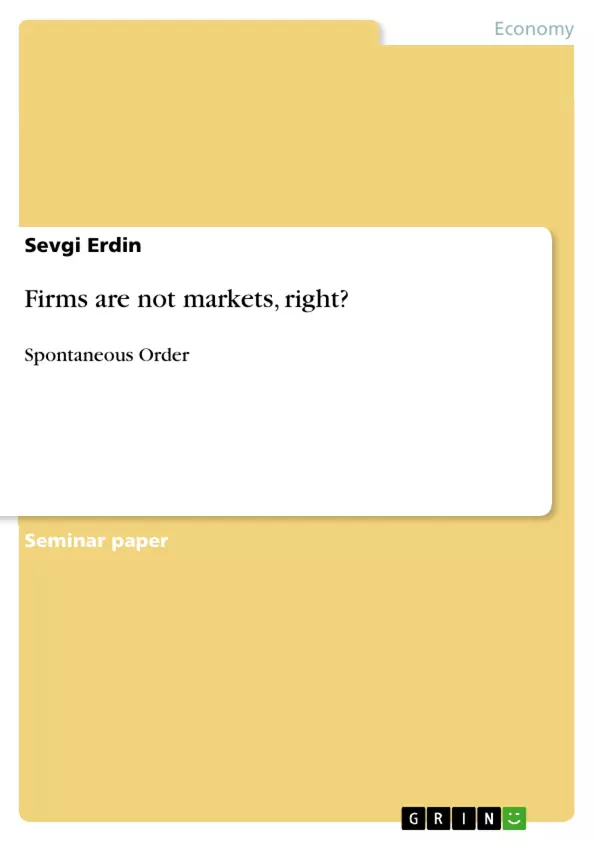This paper asks whether firms are markets and examines the difference and similarities of these dynamics depending on the result it goes beyond the theory of a firm. It appeals a self- organizing rule that may result in an alternative organization model to the capitalist enterprises controlled by a central authority.
Furthermore, it focuses to general definition of the alternative model “Spontaneous order” and enlightens this concept through the different views of economists like David Hume, Adam Smith and Friedrich von Hayek. In order to examine the feasibility and permanence of the Spontaneous order, the paper finds the building blocks of this model by showing some theories based on real life examples, followed by management of firms with definition of vertical and horizontal organization. Additionally, the structure of vertical and horizontal organization will be compared.
Inhaltsverzeichnis (Table of Contents)
- Introduction
- Spontaneous Order
- Definition
- Different Contributions
- Management of firms
- Definition of vertical and horizontal organization
- Vertical vs. horizontal organization structure
- Convention
- Social orders subsume convention
- Is it rational to follow the convention?
- Case Study: Valve
- How does it work
- The future of valve
- Conclusion
Zielsetzung und Themenschwerpunkte (Objectives and Key Themes)
This paper explores the relationship between firms and markets, specifically examining whether firms can be considered markets. It aims to analyze the differences and similarities between these two models of organization, going beyond traditional theories of the firm. The paper explores the concept of spontaneous order, an alternative organization model that emerges without centralized control, and examines its feasibility and potential application to modern firms. Here are some of the key themes explored in the paper:- The nature of spontaneous order and its origins
- The contributions of various economists to the understanding of spontaneous order
- The role of conventions in shaping social orders
- The rationality of following conventions
- The application of spontaneous order to firms, particularly through the case study of Valve
Zusammenfassung der Kapitel (Chapter Summaries)
Introduction
The introduction lays out the central question of the paper: are firms essentially markets? The paper aims to delve deeper than traditional firm theory, exploring the possibility of alternative organizational models, particularly the concept of "spontaneous order."Spontaneous Order
This chapter defines spontaneous order as a self-organizing system that emerges without a central authority. It highlights the contributions of various economists like David Hume, Adam Smith, and Friedrich von Hayek to the concept, demonstrating its historical significance.Management of Firms
This chapter focuses on the different organizational structures within firms, particularly vertical and horizontal structures. It delves into the definitions and characteristics of these structures, outlining the advantages and disadvantages of each.Convention
This section explores the relationship between conventions and social orders. It argues that conventions, as shared understandings and behaviors, are integral to the formation and maintenance of social order. The chapter also examines the rationality of following conventions using game theory and the concept of Nash Equilibrium.Case Study: Valve
The paper concludes with a case study of Valve, a gaming company known for its unconventional organizational structure. The study examines Valve's unique organizational model and explores the potential implications for the future of the company.Schlüsselwörter (Keywords)
This paper focuses on the concepts of firms, markets, spontaneous order, conventions, social orders, organizational structures, vertical organization, horizontal organization, game theory, Nash Equilibrium, and the case study of Valve.- Quote paper
- Sevgi Erdin (Author), 2013, Firms are not markets, right?, Munich, GRIN Verlag, https://www.grin.com/document/268352



